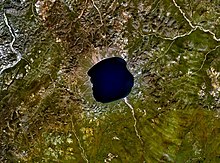Lake Elgygytgyn
| Elgygytgyn Lake | |
|---|---|
 View of the lake | |
| Location | Chukchi Peninsula, northeast Siberia |
| Coordinates | 67°30′N 172°00′E / 67.500°N 172.000°E |
| Type | Impact crater lake, oligotrophic |
| Primary outflows | Enmyvaam |
| Catchment area | 293 km2 (113 sq mi) |
| Basin countries | Russia |
| Max. length | 12 km (7.5 mi) |
| Max. width | 12 km (7.5 mi) |
| Surface area | 110 km2 (42 sq mi) |
Lake Elgygytgyn, also transcripted El'gygytgyn, (Russian and Chukchi: Эльгыгытгын) is a crater lake in Anadyrsky District, Chukotka Autonomous Okrug in northeast Siberia, about 150 km (93 mi) southeast of Chaunskaya Bay.
The word "Elgygytgyn" means "white lake" in the Chukchi language.
The lake is of particular interest to scientists because it has never been covered by glaciers. This has allowed the uninterrupted build-up of 400 m (1,300 ft) of sediment at the bottom of the lake, recording information on prehistoric climate change.
Geography
[edit]
Lake Elgygytgyn is an impact crater lake located in the Anadyr Plateau, part of the Anadyr Highlands. It is drained to the southeast by the Enmyvaam, a tributary of the Belaya. It is approximately 12 km (7 mi) in diameter and has a maximum depth of 174 ± 2 m (571 ± 7 ft). The lake is centered within an impact crater with a rim diameter of 18 km (11 mi) that formed 3.6 million years ago during the Pliocene.[1] Before it was reliably dated, preliminary papers in the late 1970s suggested either Elgygytgyn[2] or Zhamanshin[3] as the source of the young Australasian strewnfield.
Scientific drilling
[edit]In late 2008 and early 2009, an international team conducted a drilling program targeting three holes in Elgygytgyn Lake. The resulting cores are designated ICPD Site 5011-1 and 5011-3.[4]
Fauna
[edit]The conditions in Elgygytgyn lake are extremely severe for fish life, being classed as an ultra-oligotrophic lake and the surface covered by ice for around 10 months of the year. Even so, there are three species permanently inhabiting the lake's harsh aquatic environment, all species of char.[5] These are Salvelinus boganidae (Boganid Char), S. elgyticus (Small-mouth Char) and Salvethymus svetovidovi (Long-finned Char).[6] The two latter species are endemic to the Elgygytgyn lake. All three species are adapted to the lake's extremely cold waters, which are generally just above the freezing point, and spend most of the year in total darkness. It may start to melt in the summer, but some years it never fully thaws.[7] The lake is also home to more than a dozen endemic diatoms.
See also
[edit]References
[edit]- ^ "El'gygytgyn". Earth Impact Database. Planetary and Space Science Centre University of New Brunswick Fredericton. Retrieved 2009-08-19.
- ^ R.S. Dietz (1977), Elgygytgyn Crater, Siberia: Probable Source Of Australasian Tektite Field Meteoritics, June 1977, Vol 12, Issue 2, p. 145–157
- ^ B.P. Glass (1979), Zhamanshin crater, a possible source of Australasian tektites? Geology, July 1979, v. 7, p. 351-353
- ^ Melles; et al. (2011). "The Lake El'gygytgyn Scientific Drilling Project – Conquering Arctic Challenges through Continental Drilling". Scientific Drilling. 11 (10): 29. Bibcode:2011SciDr..11...29M. doi:10.2204/iodp.sd.11.03.2011.
- ^ Fly Fishing Russia – The Elgygytgyn Lake, Chukotka
- ^ Salvethymus svetovidovi
- ^ Arctic char (Salvelinus alpinus) in the lake
External links
[edit]- Dr. Matt Nolan at the University of Alaska Fairbanks
- Polar Expedition to Siberian Lake will Yield Details of Past Climate PhysOrg.com.
- NASA Earth Observatory
- Haltia E. M., Nowaczyk N. R. Magnetostratigraphy of sediments from Lake El’gygytgyn ICDP Site 5011-1: paleomagnetic age constraints for the longest paleoclimate record from the continental Arctic, 2014.
Lua error in Module:Navbox at line 192: attempt to concatenate field 'argHash' (a nil value).



